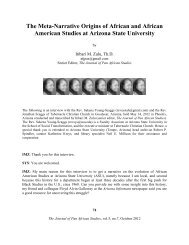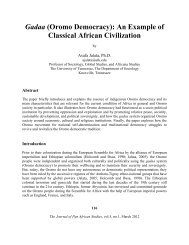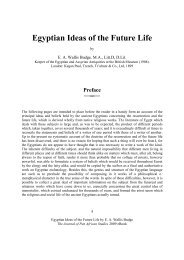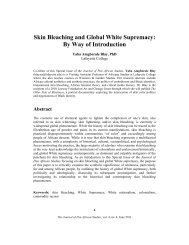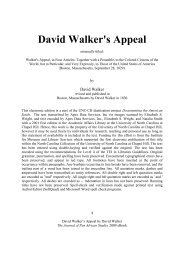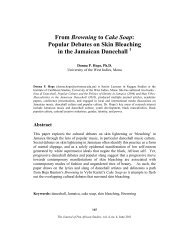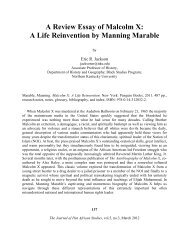The Kilumi Rain Dance in Modern Kenya - Journal of Pan African ...
The Kilumi Rain Dance in Modern Kenya - Journal of Pan African ...
The Kilumi Rain Dance in Modern Kenya - Journal of Pan African ...
You also want an ePaper? Increase the reach of your titles
YUMPU automatically turns print PDFs into web optimized ePapers that Google loves.
Summon<strong>in</strong>g the Spirits<br />
Based on 2008 ritual re-enactments, the ra<strong>in</strong> mak<strong>in</strong>g rite beg<strong>in</strong>s with libations and<br />
prayers. 29 At this stage, it is clear that there are different participant roles. Unlike many rituals,<br />
the ra<strong>in</strong> mak<strong>in</strong>g ritual does not have one orchestrator. Instead, the elders, dancers, musicians, and<br />
observers all make up the ritual experience collectively, which could cont<strong>in</strong>ue for several days.<br />
<strong>The</strong> elders serve as the <strong>in</strong>itial po<strong>in</strong>t <strong>of</strong> contact to the ra<strong>in</strong> mak<strong>in</strong>g spirits. Other key participants<br />
are the musicians who are tra<strong>in</strong>ed <strong>in</strong> the precise ra<strong>in</strong> mak<strong>in</strong>g rhythms. <strong>The</strong> dancers’ bodies are<br />
the dom<strong>in</strong>ant symbol, and the power associated with the dancers’ movements provide the<br />
necessary energy to help <strong>in</strong>voke the spirits and heal<strong>in</strong>g. <strong>The</strong> community, <strong>in</strong> this ritual, is the<br />
victim; therefore, other observers <strong>in</strong> the ritual serve as the symbolic representation <strong>of</strong> the<br />
community that needs heal<strong>in</strong>g, while simultaneously serv<strong>in</strong>g as witnesses to the ceremony.<br />
Furthermore, their presence transmits vital energy that assists the ritual. <strong>The</strong> f<strong>in</strong>al role is that <strong>of</strong><br />
the unseen ra<strong>in</strong> spirit, which may or may not attend, but, as mentioned earlier, is a key force <strong>in</strong><br />
whether or not the community can expect future ra<strong>in</strong>.<br />
<strong>The</strong> libation acts call the spirits to receive the forthcom<strong>in</strong>g rites and reveal the<br />
circumstances <strong>of</strong> the drought. This <strong>in</strong>itial call varies <strong>in</strong> length and can take on many forms.<br />
Figure 1.0 is an image <strong>of</strong> the elders pour<strong>in</strong>g milk libations to the ancestors to <strong>in</strong>voke the spiritual<br />
world. This commences the ra<strong>in</strong> mak<strong>in</strong>g dance ceremony. <strong>The</strong> duration <strong>of</strong> the libation is<br />
dependent upon the elder’s satisfaction that a suitable prayer and call has been <strong>in</strong>itiated. As<br />
witnesses, the elders <strong>in</strong>itiated libations, poured milk for the ancestors, and then drank from the<br />
calabash. <strong>The</strong>y use milk, <strong>in</strong> particular, <strong>in</strong> these ceremonies because the Wakamba view milk as<br />
hav<strong>in</strong>g the properties necessary for more bless<strong>in</strong>gs. 30 Dur<strong>in</strong>g the ceremony, only men were<br />
allowed to dr<strong>in</strong>k the milk, show<strong>in</strong>g the cont<strong>in</strong>uity <strong>of</strong> traditional gender roles. Despite modern<br />
pressures for the Akamba, men are still regarded as authorities and therefore leaders <strong>in</strong> important<br />
community matters.<br />
177<br />
<strong>The</strong> <strong>Journal</strong> <strong>of</strong> <strong>Pan</strong> <strong>African</strong> Studies, vol.4, no.6, September 2011



